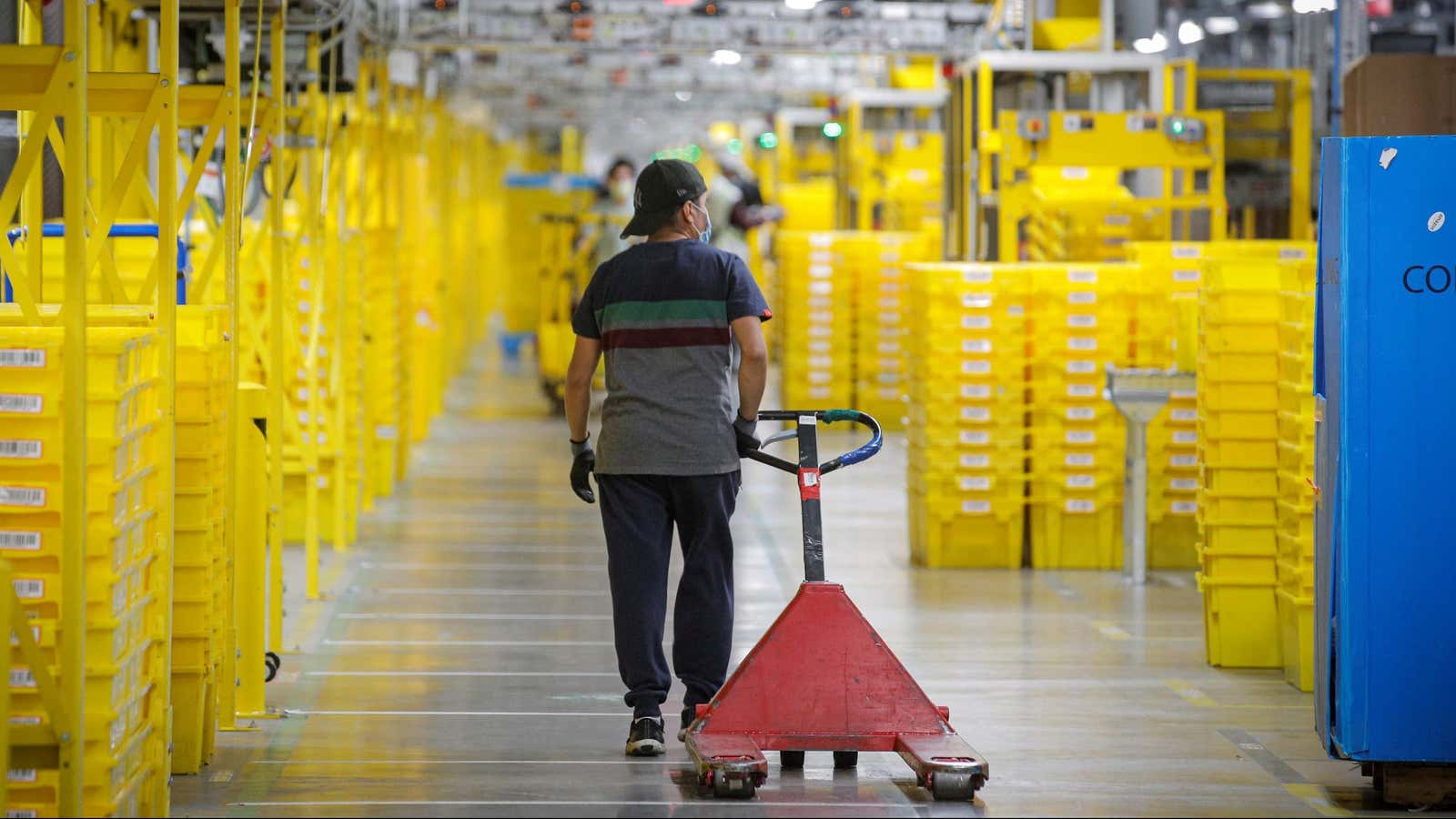Amazon warehouse workers in Bessemer, Alabama, voted against unionizing last week, with a decisive majority opting not to join the Retail, Wholesale and Department Store Union.
The decision, with a vote of 738 employees in favor to 1,798 against, was a blow to labor advocates who had been hoping that unionization at the site might inspire a wave of elections among the more than 500,000 Amazon warehouse workers in the US. But it succeeded in drawing national attention to the problems that made Amazon workers interested in organizing in the first place.
One of Amazon’s talking points in the run-up to the Bessemer vote was that the starting pay for warehouse workers is $15.30, plus medical benefits—the implication being that the company pays a reasonable wage and that workers therefore ought to have no need to unionize.
Whether $15.30 per hour is sufficient as a living wage, and fair for such physically taxing work, is debatable, though it’s certainly a lot more than the current US federal minimum wage of $7.25 per hour. But Amazon warehouse workers who have spoken out about their employer have focused on issues that go beyond pay. They have raised concerns about health and safety (particularly during the pandemic); overly strenuous productivity goals that leave them with little time for bathroom breaks; working under strict tracking systems; and being assigned “megacycle” shifts of 10.5 hours.
In sum, what workers fundamentally want is more control over their own bodies and schedules.
“Clearly the push to organize is not just wanting to get better pay, but also wanting to improve the conditions of the work by making it somewhat less demanding and less taxing,” says Alec MacGillis, author of the new book Fulfillment: Winning and Losing in One-Click America.
Amazon isn’t known for ever ceding control
The desire for autonomy is universal. But giving workers more of it means ceding some degree of control to them, and control is something that Amazon is likely to be loath to give up. Its warehouses are “optimized for a certain version of productivity,” says Matthew Bidwell, an associate professor at the Wharton School of Management at the University of Pennsylvania—a version that, Bidwell says, structures work around the question of “how do we get people to behave like robots?”
Employees have used that same metaphor to describe their struggles to keep up with Amazon’s productivity expectations; the failure to do so can mean losing your job. Even comparatively benevolent reviews of what it’s like to work at a fulfillment center say the experience is “both boring and extremely isolating,” with computers ranking people in real time on their performance compared to their co-workers and sending automatic messages when they’re processing items too slowly.
These tactics are similar to assembly-line practices American manufacturers have famously employed before, but they come with costs for both workers and, ultimately, their employers.
“The US car plants were thoroughly dehumanizing in how they treated people, and they paid the price in terms of absenteeism, strikes, shoddy workmanship, all of those sorts of things,” Bidwell says. In the early 1970s, for example, workers at GM’s Lordstown, Ohio, plant famously rebelled against a newly sped-up assembly line that made it impossible to accurately assemble cars, going on strike in an effort not just to lower the pace of work to a doable speed but to change the monotony of their jobs.
Eventually, many US automakers adopted something closer to Toyota’s system, creating self-managed teams and inviting workers to help management design work processes rather than having them imposed from above. “In manufacturing, it turned out, not only did the workers tend to prefer it, but it actually worked out to be much more efficient,” Bidwell says.
It will be tough to get Amazon to change its ways, particularly so long as American consumers continue to place so much value on convenience and two-day delivery turnarounds. But the expense and distraction of fending off future organizing efforts, even given Amazon’s victory in Bessemer, might provide the $1.7 trillion company with some extra motivation to reconsider the way it structures work.
The limits of what unions can do
Unions can certainly address some concerns about dehumanizing working conditions, MacGillis says—they can bargain for more break time, more realistic productivity goals, and less surveillance. “The unions can help with the strenuousness [of the jobs] just by adding more time and making you feel somewhat less of a mere cog,” he says.
But the repetitive, automized nature of warehouse work, MacGillis says, is harder to change—and so long as Amazon employs hundreds of thousands of fulfillment-center workers in the US, that means a lot of current and future blue-collar workers will be in jobs that they may find less meaningful than American manufacturing jobs of the past.
“It’s much less well-paid than assembly line work was,” MacGillis says. “And it’s also less gratifying or fulfilling.”
There might not be much Amazon can do about that, though its advertising team seems to be trying.
Certainly there are factors, beyond an overarching sense of purpose, influencing the degree of autonomy and humanity that people feel on the job. Is Amazon prepared to make enough of the changes its workers are looking for? We reached out to Amazon to ask but the company did not respond.
Says Bidwell, “Rethinking how you manage people, how you control the work, how you schedule, how you set targets, those sorts of things—if they were serious about avoiding unions, I think those are the things they would need to look at very, very carefully.”
